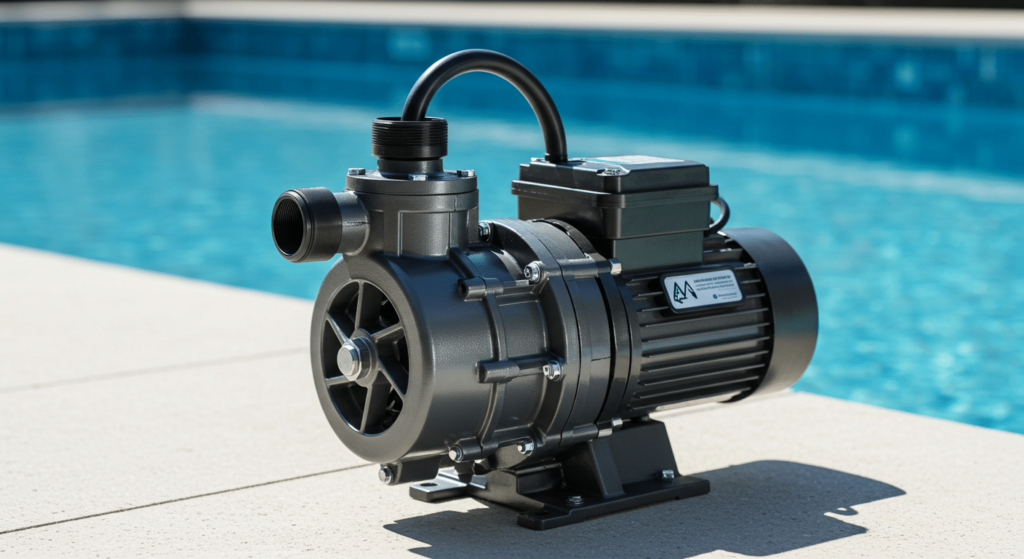Choosing the right pump size for your pool can be a daunting task, leading to inefficient circulation and costly energy bills if done incorrectly.
Undersized pumps struggle to maintain proper water clarity and chemistry, while oversized pumps waste energy and money.
By following our step-by-step guide, you’ll learn how to accurately calculate your pool’s specific requirements and select the perfect pump to keep your pool crystal clear and your wallet happy.

Step 1: Calculate Your Pool Volume
To determine the appropriate pump size for your pool, start by calculating your pool’s volume in gallons.
| Pool Shape | Primary Formula | Key Considerations |
|---|---|---|
| Rectangular/Square | Length (ft) x Width (ft) x Average Depth (ft) x 7.5 = Volume (Gallons) | Use average depth for pools with varying depths. |
| Round/Circular | 3.14 x Radius (ft) x Radius (ft) x Average Depth (ft) x 7.5 = Volume (Gallons) | Radius = Diameter / 2. Most round pools have a single depth. |
| Oval | 3.14 x Length (ft) x Width (ft) x 0.25 x Average Depth (ft) x 7.5 = Volume (Gallons) | Use average depth. Formula based on area of an ellipse is recommended for accuracy. |
| Kidney-Shaped | (A + B) x Length x 0.45 x Average Depth x 7.5 = Volume (Gallons) (A & B are widest points) | This is an approximation. More accurate method involves breaking down into simpler shapes. |
| Freeform | Longest Length x Widest Width x Average Depth x 5.9 = Volume (Gallons) | This is a rough approximation. Breaking down into simpler shapes or using multiple measurements is more accurate. |
Step 2: Pool Turnover Rate
The turnover rate refers to how often all the water in your pool circulates through the filtration system. As a general rule, aim to turn over your pool water at least once every 8 hours, or 3 times per day.
Some pools may require a faster turnover rate. For example:
- Commercial pools
- Pools used by a high number of swimmers
- Pools in climates with very hot summers
In these cases, a 6-hour turnover rate allowing 4 complete water circulations per day is recommended. Check your local pool codes to see if a specific turnover rate is mandated.
Step 3: Determine the Required Flow Rate
Now that you have your pool’s volume and target turnover rate, you can calculate the required flow rate for your pump. Use this formula:
Flow Rate (gallons per minute) = Pool Volume (gallons) / Turnover (hours) / 60 (minutes per hour)
For example, let’s say you have a 20,000 gallon pool and want an 8 hour turnover rate:
20,000 gallons / 8 hours / 60 minutes = 41.67 gallons per minute (gpm)
Round this number up to the nearest whole number, giving a 42 gpm flow rate requirement.
When shopping for a pool pump, look for models that provide at least your required flow rate while accounting for the head pressure of your pool’s plumbing. Consult the pump’s flow curve chart to ensure it will deliver sufficient flow at your pool’s head pressure.
Choosing a pump with some extra flow capacity beyond the minimum required rate will allow for some future head pressure increase as the filtration system ages and accumulates debris.
Step 4: General HP Guidelines
As a general rule of thumb, the following HP ranges are recommended based on pool size:
- Large pools (over 30,000 gallons): 1.5 to 3 HP
- Small pools (less than 13,000 gallons): 0.5 to 1 HP
- Medium pools (13,000-30,000 gallons): 0.75 to 2 HP
Several factors influence the pump size needed for your pool:
- Filter Type and Size: The filter type (sand, cartridge, or DE) and its size affect the pump’s required flow rate. Consult the filter manufacturer’s specifications for optimal flow rates.
- Plumbing System: The size and configuration of your pool’s plumbing system, including pipe diameter and length, number of fittings, and valves, impact the pump’s performance. Larger pipes and fewer fittings reduce friction and allow for more efficient water flow.
- Additional Features: Water features like waterfalls, fountains, or spa jets require additional pumping power.
- Head Loss: Head loss refers to the resistance to flow caused by elevation changes, friction, and other factors. Higher head loss requires a more powerful pump to maintain the desired flow rate.
Step 5: Choosing the Right Pump
Select a pump that meets your pool’s flow rate requirements while considering energy efficiency and noise levels. Here are three common pump types:
- Single-Speed Pumps: These pumps operate at a constant speed and are the most affordable option. However, they are less energy-efficient and may be noisier than other pump types.
- Dual-Speed Pumps: Dual-speed pumps offer high and low-speed settings, providing greater flexibility and improved energy efficiency compared to single-speed pumps.
- Variable-Speed Pumps: Variable-speed pumps allow you to adjust the pump speed to meet your pool’s specific needs, resulting in significant energy savings and quieter operation. While more expensive upfront, they often pay for themselves through reduced energy costs over time.

